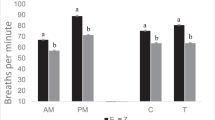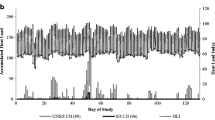Abstract
Exposure to hot environments affects milk yield (MY) and milk composition of pasture and feed-pad fed dairy cows in subtropical regions. This study was undertaken during summer to compare MY and physiology of cows exposed to six heat-load management treatments. Seventy-eight Holstein-Friesian cows were blocked by season of calving, parity, milk yield, BW, and milk protein (%) and milk fat (%) measured in 2 weeks prior to the start of the study. Within blocks, cows were randomly allocated to one of the following treatments: open-sided iron roofed day pen adjacent to dairy (CID) + sprinklers (SP); CID only; non-shaded pen adjacent to dairy + SP (NSD + SP); open-sided shade cloth roofed day pen adjacent to dairy (SCD); NSD + sprinkler (sprinkler on for 45 min at 1100 h if mean respiration rate >80 breaths per minute (NSD + WSP)); open-sided shade cloth roofed structure over feed bunk in paddock + 1 km walk to and from the dairy (SCP + WLK). Sprinklers for CID + SP and NSD + SP cycled 2 min on, 12 min off when ambient temperature >26°C. The highest milk yields were in the CID + SP and CID treatments (23.9 L cow−1 day−1), intermediate for NSD + SP, SCD and SCP + WLK (22.4 L cow−1 day−1), and lowest for NSD + WSP (21.3 L cow−1 day−1) (P < 0.05). The highest (P < 0.05) feed intakes occurred in the CID + SP and CID treatments while intake was lowest (P < 0.05) for NSD + WSP and SCP + WLK. Weather data were collected on site at 10-min intervals, and from these, THI was calculated. Nonlinear regression modelling of MY × THI and heat-load management treatment demonstrated that cows in CID + SP showed no decline in MY out to a THI break point value of 83.2, whereas the pooled MY of the other treatments declined when THI >80.7. A combination of iron roof shade plus water sprinkling throughout the day provided the most effective control of heat load.


Similar content being viewed by others
References
Bernabucci U, Lacetera N, Ronchi B, Nardone A (2002) Effects of the hot season on milk protein fractions in Holstein cows. Anim Res 51:25–33
Berry IL, Shanklin MD, Johnson HD (1964) Dairy shed design based on milk production decline as affected by temperature and humidity. Trans ASEA 7:329–331
Bond TE, Kelly CF, Morrison SR, Pereira N (1967) Solar, atmosphere, and terrestrial radiation received by shaded and unshaded animals. Trans ASAS 10:622–629
Brügemann K, Gernand E, von Borstel UK, König S (2012) Defining and evaluating heat stress thresholds in different dairy cow production systems. Archiv Tierzucht 55:12–24
Chen JM, Schütz KE, Tucker CB (2015) Cooling cows efficiently with sprinklers: physiological responses to water spray. J Dairy Sci 98:6925–6938
Curtis SE (1983) Environmental management in agriculture. Iowa State University Press, Ames, IA
Davison TM, Silver BA, Lisle AT, Orr WN (1988) The influence of shade on milk production of Holstein-Friesian cows in a tropical upland environment. Aust J Exp Agr 28:149–154
du Preez JH, Giesecke WH, Hattingh PJ (1990) Heat stress in dairy cattle and other livestock under southern African conditions. I. Temperature-humidity index mean values during the four main seasons. Onderstepoort J Vet Res 57:77–87
Flamenbaum I, Wolfenson D, Mamen M, Berman A (1986) Cooling dairy cows by a combination of sprinkling and forced ventilation and its implementation in the shelter system. J Dairy Sci 69:3140–3147
Fuquay JW (1981) Heat stress as it affects animal production. J Anim Sc 52:164–174
Gaughan JB, Goodwin PJ, Schoorl TA, Young BA, Imbeah M, Mader TL, Hall A (1998) Shade preferences of lactating Holstein-Friesian cows. Aust J Exp Agric 38:17–21
Ingraham RH, Gillette DD, Wagner WD (1974) Relationship of temperature and humidity to conception rate of Holstein cows in subtropical climate. J Dairy Sci 57:476–481
Johnson HD, Ragsdale AC, Berry IL, Shanklin ND (1962) Effect of various temperature-humidity combinations on milk production of Holstein cattle. Univ Mo Res Bull ZZ 791:1–39
Lees JC, Gaughan JB (2011) Effect of yearly climate on milk yield in a sub-tropical environment. J Anim Sci 89(E-Suppl. 1):412
Lin JC, Moss BR, Koon JL, Flood CA, Smith RC III, Cummins KA, Coleman DA (1998) Comparison of various fan, sprinkler, and mister systems in reducing heat stress in dairy cows. Appl Eng Agric 14:177–182
Mayer DG, Davison TM, McGowan MR, Young BA, Matschoss AL, Hall AB, Goodwin PJ, Jonsson NN, Gaughan JB (1999) Extent and economic effect of heat loads on dairy production in Australia. Aust Vet J 77:804–808
McCullagh P, Nelder JA (1989) Generalized linear models (2nd ed). Chapman and Hall, London, UK
Means SL, Bucklin RA, Nordstedt RA, Beede DK, Bray DR, Wilcox CJ, Sanchez WK (1992) Water application rates for a sprinkler and fan cooling system in hot humid climates. Trans ASAE 8:375–379
Morton JM, Tranter WP, Mayer DG, Jonsson NN (2007) Effcts of environmental heat on conception rates in lactating dairy cows: critical periods of exposure. J Dairy Sci 90:2271–2278
Ominski KH, Kennedy AD, Wittenberg KM (2002) Physiological and production responses to feeding schedule in lactating dairy cows exposed to short-term, moderate heat stress. J Dairy Sci 85:730–737
Rodriguez LA, Mekonnen G, Wilcox CJ, Martin FG, Krienke WA (1985) Effects of relative humidity, maximum and minimum temperature, pregnancy and stage of lactation on milk composition and yield. J Dairy Sci 68:973–978
Schütz KE, Cox NR, Tucker CB (2014) A field study of the behavioral and physiological effects of varying amounts of shade for lactating cows at pasture. J Dairy Sci 97:3599–3605
St-Pierre NR, Cobanov B, Schnitkey G (2003) Economic loses from heat stress by US livestock industries. J Dairy Sci 86(E Suppl):E52–E57
Thom EC (1959) The discomfort index. Weatherwise 12:57–59
Tucker CB, Rogers AR, Schütz KE (2008) Effect of solar radiation on dairy cattle behaviour, use of shade and body temperature in a pasture-based system. Appl Anim Behav Sci 109:141–154
Valtorta SE, Gallardo MR (2004) Evaporative cooling for Holstein dairy cows under grazing conditions. Int J Biometeorol 48:213–217
West JW (2003) Effects of heat-stress on production in dairy cattle. J Dairy Sci 86:2131–2144
Wolfenson D, Thatcher WW, Badinga L, Savio JD, Meidan R, Lew BJ, Braw-Tal R, Berman A (1995) Effect of heat stress on follicular development during the oestrous cycle in lactating dairy cattle. Biol Reprod 52:1106–1113
Acknowledgments
The authors acknowledge the technical assistance of Nikki Casey, Warren Orr, Annette Matschoss, and Peter Martin and staff at Health and Food Sciences Precinct Coopers Plains, Brisbane, Australia, for chemical analysis of feed and pasture samples. This research was supported by the Department of Employment Economic Development and Innovation (Queensland), Dairy Australia, and The University of Queensland, Australia.
Author information
Authors and Affiliations
Corresponding author
Ethics declarations
The Animal Ethics Committee of the Department of Agriculture, Fisheries and Forestry (Queensland) approved this experiment.
Rights and permissions
About this article
Cite this article
Davison, T.M., Jonsson, N.N., Mayer, D.G. et al. Comparison of the impact of six heat-load management strategies on thermal responses and milk production of feed-pad and pasture fed dairy cows in a subtropical environment. Int J Biometeorol 60, 1961–1968 (2016). https://doi.org/10.1007/s00484-016-1183-2
Received:
Revised:
Accepted:
Published:
Issue Date:
DOI: https://doi.org/10.1007/s00484-016-1183-2




